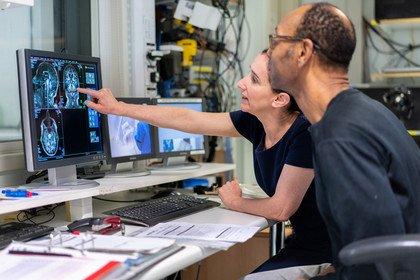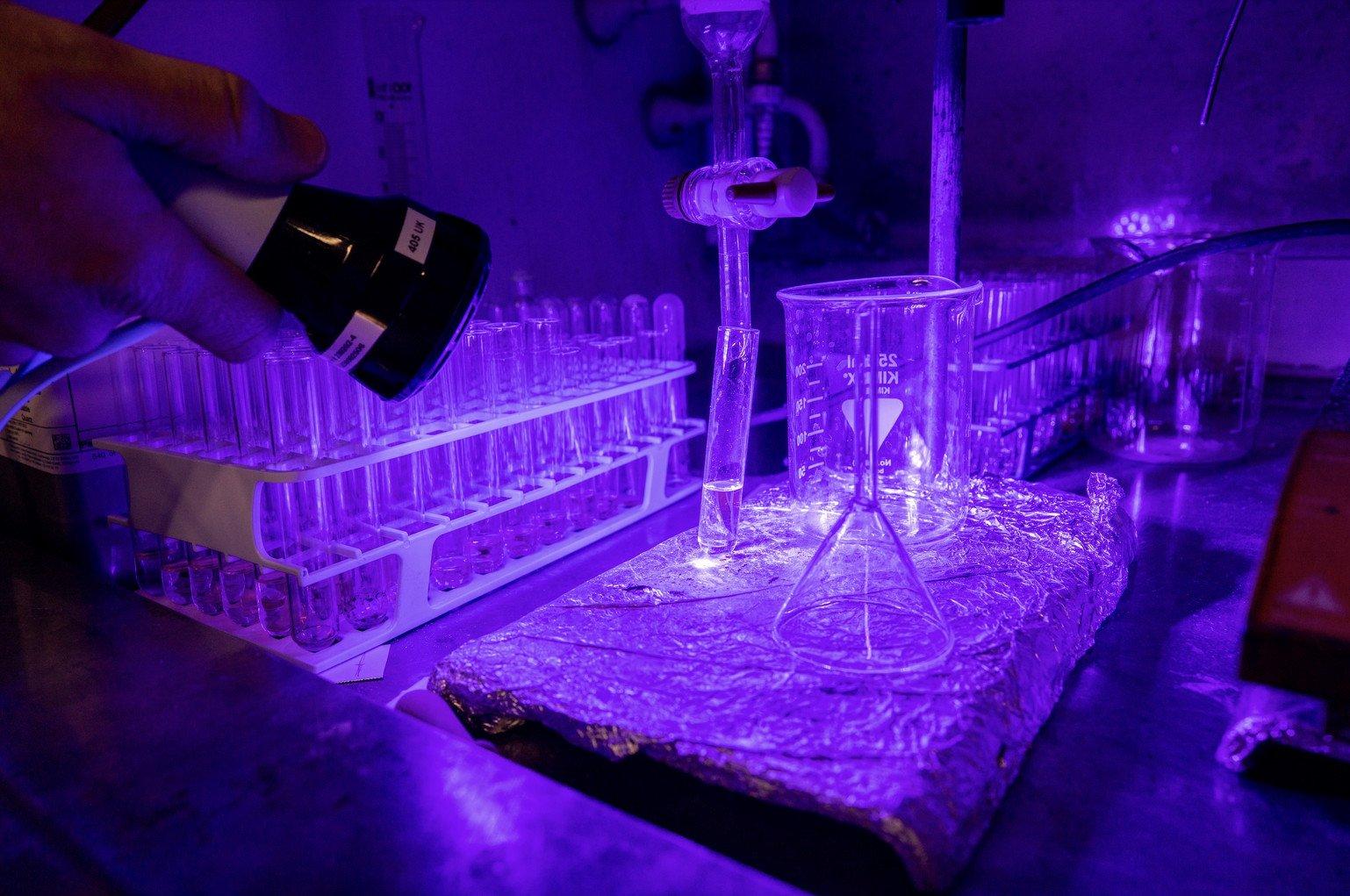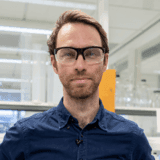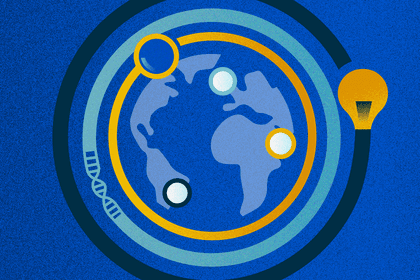
How can we understand Parkinson's dementia better?
Dr Rimona Weil, a neurologist and neuroscientist at University College London, tells us about how she's using advanced neuroimaging to better understand Parkinson's dementia.
Understanding how human cells and tissues operate can help us fight diseases and develop new drugs. Creating lab-based models of tissues is one way to do this, but it has its challenges. In their research, Dr Chris Spicer and his team are tackling this head-on using newly engineered biomaterials.

Patrick Shepherd / Wellcome

Chemistry Lecturer, University of York

Chemistry Lecturer, University of York
Human tissue research is mostly performed by biologists, and there are far fewer chemists exploring this important area. However, I’m a firm believer in working across disciplines to uncover new ideas.
That’s why, as a chemistry lecturer at the University of York and a trained synthetic chemist, I’m really interested in working at the intersection of chemistry, biology and human health, and in using chemical principles to address biological questions.
I became aware of the challenges in biomaterials science, particularly the need to develop more accurate tissue models, during my post-doctoral research. On starting my independent research in York, I was therefore interested in how we could improve the materials that people use by enhancing their ability to give cells potent biochemical signals.
Now I lead an interdisciplinary team of scientists working at the interface of chemical biology, materials science, and tissue biology to achieve this goal, and deliver better lab-grown tissue models that can help advance our understanding and ability to treat disease.
A major challenge with tissue models is making them accurate enough to give us an insight into human health and disease. Many models fail to recreate the biology of the tissues found in the human body.
This is largely because the materials used to grow tissues in a lab cannot provide cells with the key biological signals they need to grow into mature and fully functional tissues.
This is a big problem for researchers interested in biological processes related to human health and disease. If the models don’t accurately recreate the diseased tissue, our ability to gain new understanding or test new medicines is limited.
While studies can be conducted using animal models, such as in rats or mice, there are ethical implications associated with this. Moreover, the physiology of a rat or an animal is very different from that of a human, so the results aren’t always reliable.
That’s where our research comes in.
Pressing play on the video above will set a third-party cookie. Please read our cookie policy for more information.
I'm Dr Chris Spicer and I'm a lecturer in chemistry at the University of York.
We’re interested in designing three dimensional materials that can serve as scaffolding to allow single human cells to grow and expand and communicate with each other like tissues that you'd find within the human body.
We're hoping that it has a very broad impact across a wide range of human diseases, especially those in which tissue damage plays a key role. We also hope that this will be taken up by pharmaceutical companies who will see the benefits of having accurate tissue models for doing their drug discovery research.
One of the materials we use the most in the lab are hydrogels. If you've ever had jelly at a kid’s party, that’s the most common hydrogel that people come across in their everyday life.
It's a structurally sound three-dimensional material, which is 95% water. It's very highly hydrated and cells really enjoy growing within these kinds of materials.
One of the major limitations of materials for growing cells and tissues at the moment is that they don't give cells many of the biological signals they need in order to grow into fully functional tissues. So, we're trying to develop new chemistries that allow us to functionalise for peptides and proteins that cells need in a way that allows us to attach them to materials and control their activity.
Although people are very good at growing cells and making them into multicellular systems, actually, the tissues that are developed tend to poorly recreate the biology of the native tissues that we have in our body.
We became really interested in how we could take the materials that people are currently using within the scientific community and how we could functionalism with potent peptides and proteins and enhance the biological signals that we're giving to cells.
And if we could do that, we could make a real difference to the quality and the maturity of the tissues that we're engineering in the lab.
So that's a big challenge right now. How can we actually start to grow tissues which are mature, that are functional, and actually recreate the really intricate details of diseased tissues? Understanding biology at the tissue level is really important if we want to be able to ultimately treat disease. But doing research on tissues is really difficult.
We can do studies within animal models, but there are obvious ethical implications with doing that research. Also, the physiology is very different between a mouse, or rat, and humans.
The most potent biological signalling molecules are the proteins that cells secrete and then bind to other cells in their vicinity. These are flasks of e-coli cells that are producing large quantities of the proteins that we're interested in.
Also, we're really interested in using light to control the activity of the peptides in proteins. To do that, we need molecules that are able to absorb the light.
And so we make a lot of molecules like these that have these really bright and beautiful colours, and that's because they're able to absorb specific wavelengths of light. By doing that, we can use different light sources to activate different biological processes at different times while we're growing in vitro tissue model.
A career development award is really important for us in allowing us to build an interdisciplinary team of researchers who can contribute to all aspects of a project. So we'll start off by hiring a synthetic chemist who can help us to build the key molecules we're going to need.
Before then starting to bring in material scientists who can help us to build the scaffolds that we want to grow our cells within, and then cellular biologists who can really drive that research forward and start to ask important biological questions based on the research that we’re developing.
Discovery research is all about having that freedom to go after big ideas where you don't always know what the outcome is going to be, but you have that freedom to learn.
We’re designing specially engineered biomaterials to deliver tissue models that better mimic the conditions in the human body.
One of the materials we use a lot are hydrogels. Hydrogels replicate some of the properties of biological tissues, and their three-dimensional structure can act as a scaffold for cells, helping them to grow, expand and communicate with each other.
We functionalise these gels with peptides, proteins and carbohydrates – key biomolecules that cells rely on to develop – in a highly modular manner, so that our technologies can be applied across many disease and cell models.
This research could have big implications for drug discovery. By testing new drug compounds on more accurate tissue models in labs, rather than isolated cells or animal models, we can better understand how they will work in the human body.
It would not only allow for more accurate science but also help to reduce the need for animals in biomedical research.
Looking ahead, our work aims to advance the understanding and treatment of a range of human diseases, particularly those that involve tissue damage such as osteoarthritis.
The modularity of our research means that the techniques and technologies we develop will be widely applicable across the field of biomedical science. This could help researchers study a range of disease processes and biological questions.
Researchers and pharmaceutical companies worldwide would benefit from having accurate tissue models for drug discovery, allowing them to screen for biological activity at an early stage.
Our research could help to improve this process and lower drug attrition rates – the percentage of drug candidates that don’t make it to market after testing and development.
Ultimately, this could improve the lives of patients suffering from diseases over the next 20 to 30 years.
To me, discovery research is about having the freedom to go after big ideas where you don’t always know what the outcome will be.
Through Wellcome’s Career Development Award, we have built an interdisciplinary team of synthetic chemists, cell biologists and material scientists to do exactly that. Together, we're advancing science and developing techniques that have the potential to significantly improve human health.
Wellcome supports bold and creative discovery research that has the potential to improve human life, health and wellbeing.
We have three recurring funding awards:
Explore our one-off funding awards:

Chemistry Lecturer, University of York
Dr Chris Spicer is a Lecturer in Chemistry at the University of York, where his interdisciplinary group develop new chemical tools to address important challenges in tissue biology and disease.

Dr Rimona Weil, a neurologist and neuroscientist at University College London, tells us about how she's using advanced neuroimaging to better understand Parkinson's dementia.

Learn about discovery research Wellcome is funding across the globe and why it’s key to our strategy